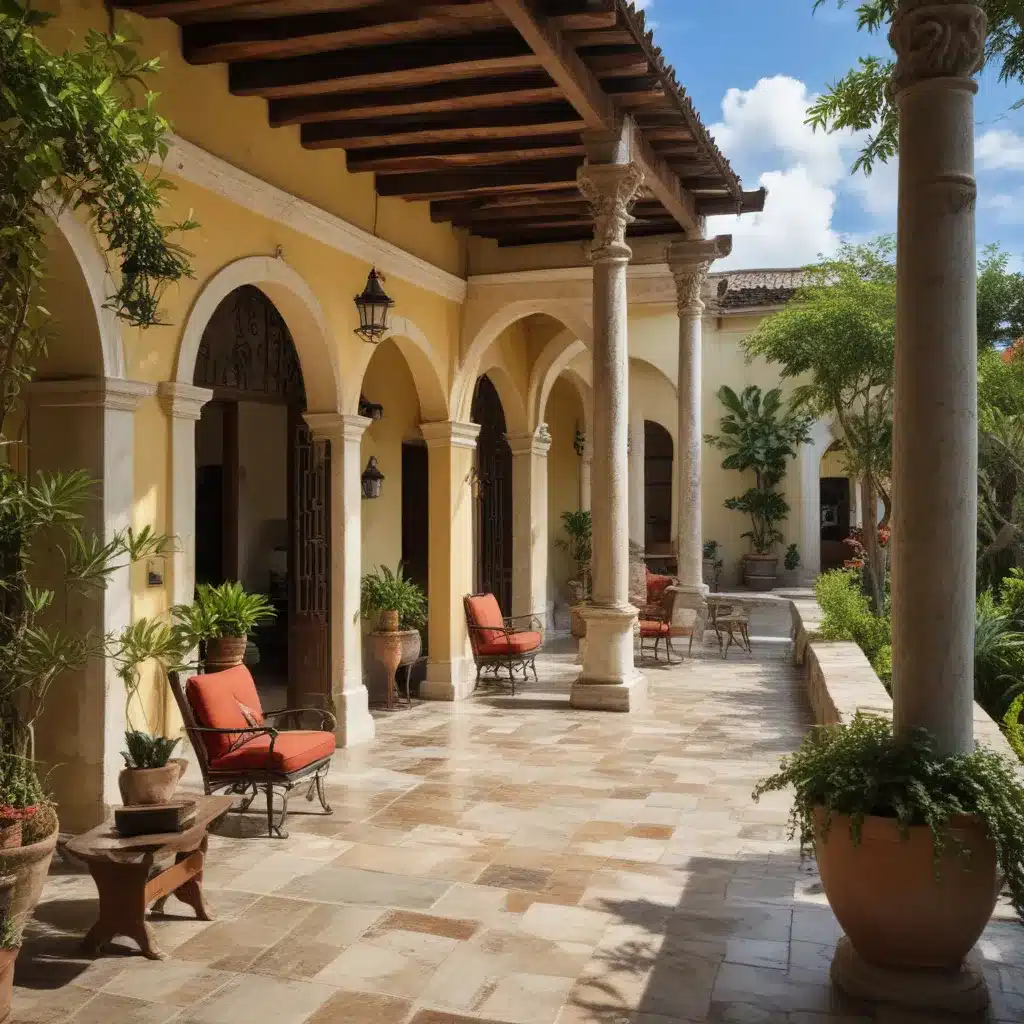
Antigua’s Architectural Allure: Patio Design Lessons from Guatemala
When it comes to creating captivating outdoor living spaces, few places offer as much inspiration as the historic city of Antigua, Guatemala. With its vibrant colonial architecture, lush landscaping, and time-honored patio design traditions, this UNESCO World Heritage site provides a wealth of design insights for homeowners and landscape enthusiasts alike.
Guatemala’s Colonial Architecture
Antigua’s architectural heritage traces back to the Spanish colonization in the 16th century. The city’s buildings showcase a unique blend of Spanish Baroque and Mudéjar styles, characterized by intricate detailing, ornate facades, and the prominent use of natural materials like stone, adobe, and tile.
A key feature of Antigua’s colonial architecture is the emphasis on courtyards and patios. These interior spaces were not only functional, providing shade and ventilation, but also served as the social and cultural heart of the home. Patios were carefully designed to reflect the owner’s wealth and status, often featuring decorative fountains, lush plantings, and paved flooring.
The materials used in Antigua’s patios were heavily influenced by the region’s natural resources. Cobblestones, terracotta tiles, and flagstone were commonly used for paving, while stucco, plaster, and wrought iron were prevalent in the architectural elements. These durable, low-maintenance materials helped to create timeless, weather-resistant outdoor spaces.
Patio Design Elements
The design of Antigua’s patios is rooted in a rich cultural heritage, with traditional patterns and motifs woven throughout. One particularly notable element is the use of geometric shapes, such as diamonds, crosses, and zigzags, which are often found in the paving patterns and decorative features.
The layout of these patios also showcases a deep understanding of spatial dynamics. Many feature a symmetrical arrangement with a central focal point, such as a fountain or sculpture, flanked by lush plantings and seating areas. This careful planning creates a sense of balance and harmony, inviting visitors to linger and immerse themselves in the tranquil atmosphere.
Decorative features in Antigua’s patios are equally captivating, with intricate tilework, carved stone elements, and wrought-iron accents adding visual interest and a touch of elegance. These design elements not only enhance the aesthetic appeal of the space but also pay homage to the region’s rich cultural heritage.
Outdoor Living Spaces
The seamless integration of interior and exterior living spaces is a hallmark of Antigua’s architectural style. Patios are often directly accessible from the home, blurring the lines between indoor and outdoor living. This connection allows for a natural flow between the two, creating a sense of openness and connectivity.
Shaded seating areas, such as covered porches and intimate alcoves, are essential components of Antigua’s outdoor living spaces. These features not only provide respite from the sun but also encourage social interaction and relaxation. The strategic placement of these spaces, often around the perimeter of the patio, enhances the overall functionality and usability of the outdoor area.
The landscaping in Antigua’s patios is equally captivating, with a focus on lush, vibrant greenery that complements the architectural elements. Flowering plants, fragrant herbs, and towering trees are common sights, creating a serene, natural oasis within the heart of the city.
Patio Paving Trends
The paving materials used in Antigua’s patios reflect the region’s rich natural resources and traditional building techniques. Cobblestones, terracotta tiles, and flagstone are the most prevalent options, each offering a unique textural quality and visual appeal.
In recent years, there has been a growing interest in sustainable paving solutions, with permeable pavers and porous concrete gaining popularity. These materials not only contribute to the environmental sustainability of the outdoor space but also enhance drainage and reduce the risk of flooding.
Installation Techniques
The proper preparation of the patio base is crucial for ensuring the long-term durability and stability of the paving materials. In Antigua, this often involves compacting the soil, laying a stable foundation, and incorporating proper drainage systems.
The laying patterns used in Antigua’s patios are as much a form of art as they are a functional necessity. Herringbone, basket weave, and running bond patterns are commonly seen, each offering a unique aesthetic and practical advantages.
The finishing touches applied to Antigua’s patios, such as grouting, sealing, and edging, play a vital role in enhancing the overall appearance and protecting the paving materials from the elements.
Maintenance Guidelines
Maintaining the beauty and functionality of Antigua’s patios requires a holistic approach. Cleaning and sealing the paving materials on a regular basis helps to prevent staining and extend their lifespan.
In the event of damage or wear, repair strategies such as patching and resurfacing can be employed to restore the patio’s appearance and structural integrity. Additionally, weatherproofing measures, such as sealants and expansion joints, can help to mitigate the impact of seasonal changes and environmental factors.
Cost Considerations
The cost of creating an Antigua-inspired patio can vary depending on a range of factors, including the choice of paving materials, the complexity of the design, and the local labor costs. High-end natural stone and custom-made architectural elements can significantly increase the overall investment, while more affordable options, such as concrete pavers and standardized tiles, can provide a cost-effective solution.
Ultimately, the long-term value of an Antigua-inspired patio lies in its timeless aesthetic, durable construction, and potential to enhance the overall appeal and functionality of the outdoor living space. By drawing inspiration from the rich architectural heritage of this remarkable Guatemalan city, homeowners can create truly captivating and enduring patio environments.

